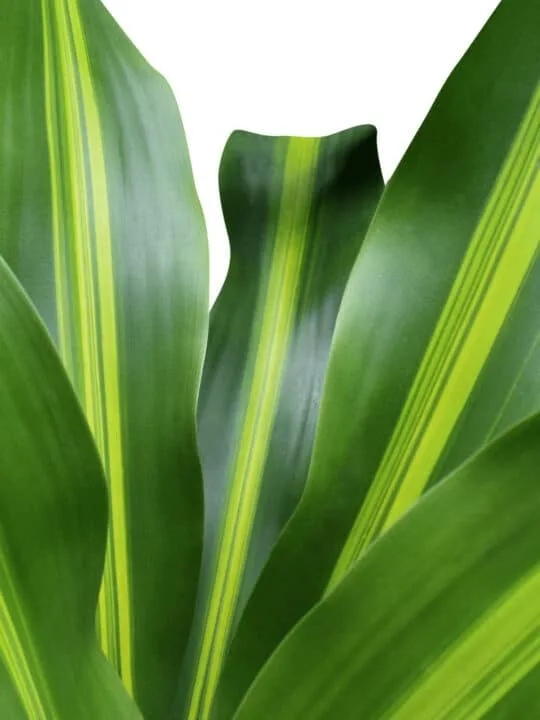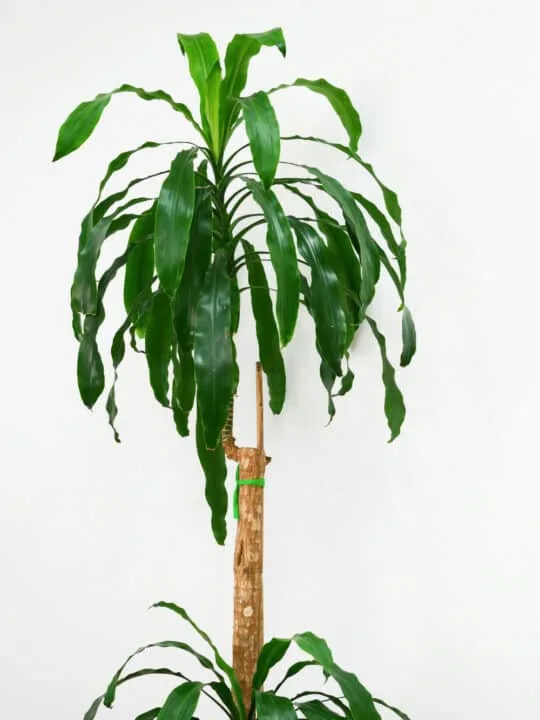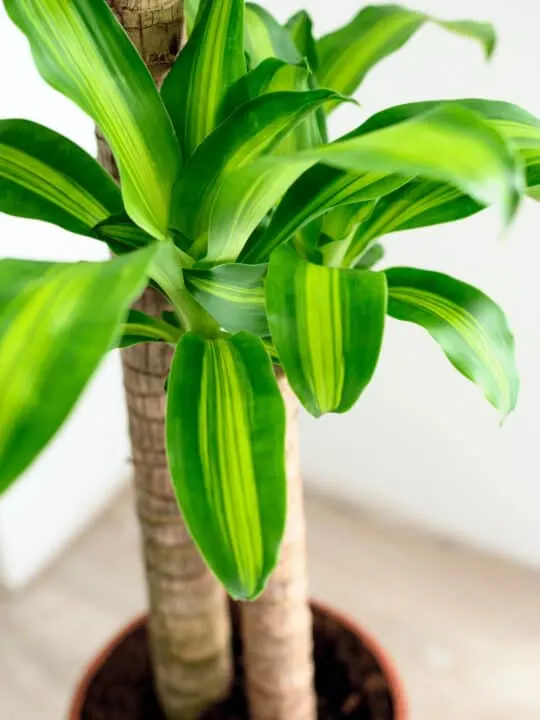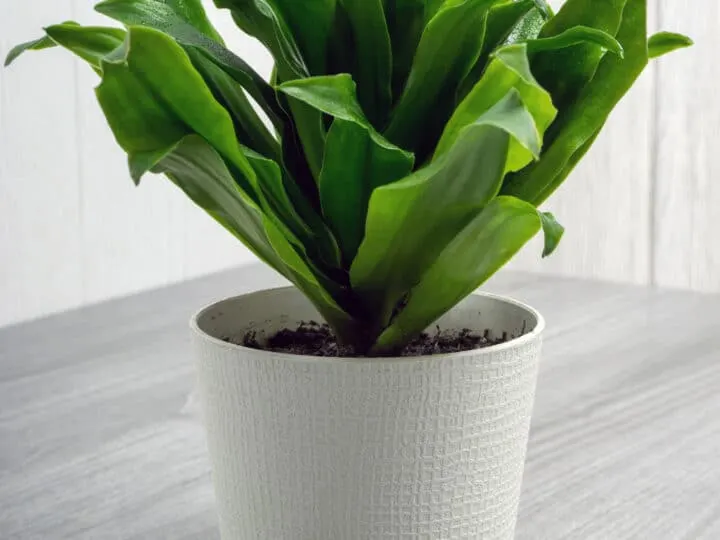Dracaena fragrans (Dra-SEE-nuh FRAY-granz), the Latin name of the Corn plant—is a flowering plant species indigenous to the continent of Africa and other islands in the Indian Ocean.
The Corn plant is a widely kept ornamental houseplant since the mid-1800s because it dwells in most indoor environments.
Dracaena fragrans Care
To care for Dracaena fragrant, provide loose, moist peaty potting soil with good drainage and bright indirect sunlight. The plant thrives in average humidity of 40-50% and a temperature between 60-75 degrees Fahrenheit (15 to 24 degrees Celsius). Water when the soil’s top 1-2 inches is partially dry. Fertilize using a balanced liquid fertilizer every three weeks during the growing season.

Table of Contents
Dracaena fragrans Care Guide
Whether growing in low or bright light, the Fragrans produces glossy green leaves.
The broad lanceolate leaves shape into an attractive crown. This crown has arching leaves at the top of a piney stem, making the Corn plant look like a small tree.
Also labeled as Fragrant Dracaena (representing fragrant flowers) or a Happy plant, this species can be grown in a shaded corner, a bright room, or an office with only fluorescent lights.
This plant was previously known as Dracaena deremensis, according to NC State University.
If you are a grower who needs a plant for a center frame in a room or a key concept, try this species for the palm-like leaves.
Dracaena fragrans grows slowly, so without much care, it can fit in a particular space for a long time.
Soil
For Dracaena, fragrans provide a well-draining potting mix of peat moss and perlite.
Potted plants like Corn always need loose, well-draining soil and plenty of organic material to grow and thrive.
Although all species in the genus Dracaena are easy to care for, they cannot stand in soggy soil material.
I create my perfect potting medium by mixing some soil with peat moss and perlite.
The suitable soil for potting should allow water to drain easily.
The simple addition of perlite generally helps to improve soil aeration and drainage. Peat moss in loamy soil contributes essential nutrients to the soil and maintains just about enough moisture.
I believe that a potting medium that is too thick allows surface water to pool.
Therefore, I suggest noting if your soil is heavy, the water will not drain as quickly as it should. Following are the two solutions that can improve your soil drainage:
- Add perlite or pumice to the potting soil to build a looser growing medium that allows water to drain freely.
- To stop the plant from being root-bound, move the Dracaena fragrans plant to a bigger jar.
Water
Water Dracaena fragrans when the top 1-2” of soil dry out (2.5-5cm).
As a rule of thumb, as soon as the top 1 inch to 2 inches (2.5-5 cm) of the soil dries out, I recommend watering the Dracaena fragrans.
Watering while the soil is partially dry avoids most problems with soil moisture. Before deciding to water, it’s always a smart idea to check how dry or moist the soil is.
Dousing the soil thoroughly and draining excess water is the perfect way to water Dracaena fragrans.
It is best to let the water sit for 24 hours in a container before watering.
This helpful tip for watering encourages the evaporation of contaminants in tap water and creates less stress for your houseplants.
Indeed, water at room temperature is better than icy-cold tap water for hydrating indoor potted plants.
Watering on a fixed schedule is one of the most common mistakes to avoid if you want to succeed with your indoor Dracaena.
Light
The best place to grow Dracaena fragrans in your house is a bright spot with bright indirect light.
While several Dracaena varieties are low-light houseplants, bright, indirect sunlight is required for the variegated types. I have found that when put in a sunny location, Corn plants grow faster.
Variegated varieties of Dracaena fragrans grow on a windowsill facing east. The early morning sun is not strong enough to burn the leaves.
Hold the plant several feet away from the window in a south or west room.
North-facing rooms or offices with artificial light are preferred for the Dracaena cultivars with dark-green foliage.
Lighting conditions will impact the growth rate of the plant. For instance, the naturally slow growth of the plant can almost come to a halt when growing in complete shade.
Also, for some species, brightly colored foliage can fade. The leaves can become discolored and wilt if they grow too long in direct sunlight.

Temperature
Dracaena fragrans grow at an average room temperature of 60 degrees Fahrenheit to 75 degrees Fahrenheit (15 degrees Celsius to 24 degrees Celsius).
To prevent sudden fluctuations, it is important to maintain the temperature as much as possible.
Temperature changes may cause stress on plants and affect their development. Aim to keep plants out and away from hot radiators and cold drafts.
As long as the median temperature is above 60 degrees Fahrenheit (15 degrees Celsius), Dracaena fragrans has good growth outdoors.
You can take potted Corn plants out in summer in temperate climates.
Keep the plants in a bright but shaded position from direct sunlight.
If the temperature drops below 50 degrees Fahrenheit (10 degrees Celsius), put it back indoors.

Humidity
You must strive for humidity levels between 40 and 50 percent for Dracaena fragrans plants to thrive.
Brown tips on the leaves usually mean that the air moisture levels should be increased as your plant is drying out.
Keeping the air humid in winter is one of the challenges of growing Dracaena plants indoors. In the house, heating appears to dry out the air.
Since Fragrans plants in the winter need less water, they can suffer from poor precipitation. Therefore, pay close attention to the room’s humidity level during winter.
Some strategies that you can follow to keep Dracaenas moisture high include:
- Misting – Fill a spray bottle with water that is distilled or filtered. Build a fine mist around the leaves of the plants without spraying the leaves directly—mist once a week for a healthy finish.
- DIY Humidifying Tray – Create a humidifying tray in a deep dish by adding a layer of pebbles. Fill the plate with water until the pebbles hit halfway up. Place the Corn plant on the stones, ensuring that the bottom of the pot is not in direct contact with the water.
- Damp Cloth Wipe – Take a wet cloth, and once a week, wash the leaves of the Fragrans plant. The dampness helps to moisturize the leaves and, at the same time, cleans them from dust.

Fertilizer
Fertilize Dracaena fragrans every 3 weeks using a balanced liquid fertilizer.
Dracaena fragrans plant doesn’t need much fertilizer because of the moderate growth rate.
Growing in organically, rich soil offers lots of good nutrients.
By using a balanced liquid fertilizer every three weeks, you can boost the Fragrans growth.
The spring and summer seasons are the growing months, and you should only feed the plant now.
Winters are the resting season for the Fragrans, during which time you should avoid feeding it.
Prevention of the accumulation of fertilizer salts in the potting soil is also essential. Yellow leaves or brown leaf tips may be caused by too much fertilizer; these symptoms are often mistaken for water problems.
One way to prevent a build-up of minerals is to wash the soil. To flush the potting mix, I follow these steps:
- Take the Dracaena fragrans to the bath or outdoors.
- Run water through the soil gently to drench it properly.
- Keep the water flowing for 3 to 5 minutes.
- Before returning the plant to its favored spot, allow all the water to drain completely.
- During the developing season, I repeat flushing two or three times.

Repotting
Every two to three years, repot Dracaena fragrans to a larger container.
This species does not mind being moderately rootbound. However, the plant’s growth can become constricted if roots fill the pot too much. Choose a container one or two sizes bigger than its current one for repotting.
Method of Repotting
This is what you should do for repotting any variety of Dracaena fragrans:
- Remove the thick stem to extract the plant’s root ball from the container.
- To clean them, shake off the accumulated dust and push the roots underwater.
- Monitor for signs of decaying or rotting on the roots and trim as appropriate.
- Fill the container halfway with the right kind of potting mix.
- Place the plant gently in the pot and fill the surrounding space with new soil.
- Lastly, water the plant thoroughly and place it in a shady area away from direct light.
Pruning
It is essential to prune Corn plants to promote growth or a bushy appearance.
As the plant grows and matures, the lower leaves gradually turn yellow and fall off. Trim these when pruning in the spring season.
If the Fragrans plant begins to grow too tall, you can prune it back to the desired size.
Propagation
You can propagate Dracaena fragrans by stem cuttings.
It’s simple to propagate Corn plants.
Since much of the foliage grows at the top of the stem, giving it a tree-like look, cornstalk plants become lanky in time.
The best way for propagation is to break the woody stem into three parts. You’ll have a section of the crown, a section of the root, and a middle segment.
- Cut the crown off first, retaining about 5 inches (12 cm) of the stem. Plant the newly cut stem in a pot with a fresh, sterile potting mix.
- Second, from the root system, cut the remaining stem about one-half of its circumference. In the cut section, new growth will emerge, forming a new crown of spiky-looking foliage.
- Thirdly, to propagate a new Dracaena fragrans, I use the middle part of the stem.
- Allow a couple of days for the cut stem to dry. Then plant the stem in a new potting medium to ensure the plant develops similarly. Keep the soil warm and moist to help the propagated stem form roots.
Blooms
Dracaena fragrans produce flowers more frequently indoors. But indoor conditions need to be optimal for the delicate white-pink flowers to bloom.
These tiny flowers (about 1 inch in size) are fragrant and sweet. Each cluster has several tiny flowers emerging from the crown. These flowers have a purple or red line in the middle. This plant will also grow orange-red fruit berries.
Instead of their less showy flowers, most people maintain the Fragrans for spiky foliage.
Growth
Dracaena fragrans, even in ideal conditions, have a slow growth rate, so they can last a long time without being too tall.
Light is the key factor influencing the growth of Dracaena; plenty of bright indirect light promotes the best growth.
The standard version of this plant has solid green leaves. But the glossy leaves on variegated varieties are dark green with several light-colored streaks. These leaves have a smooth surface. I have noticed that the young leaves grow pointing upwards but start drooping once they mature.
These slow-growing shrubs can grow to 50 feet (15 meters) when they have matured. The long, tapering leaves can grow up to 3 ft. (0.9m) long and 5 inches (13 centimeters) thick. Growing indoors, Dracaena plants easily grow up to 6 feet tall (1.8 meters) and are ideal for your home as a tall houseplant. Some common varieties of this plant are:
Dracaena fragrans Massangeana – a variegated cultivar of this plant with thin yellow stripes. This is the most famous cultivar of Fragrans.
Dracaena fragrans Lindenii – this variety has yellow stripes on the leaf edges.
Dracaena fragrans Victoria – resembles Fragrans Massangeana, but the leaves are wider and smaller. The leaves are triangular-shaped.
Dracaena fragrans Warneckii also has variegated green leaves with white stripes.
Common Problems for Dracaena fragrans
Overwatering is the reason for most diseases that affect Corn plants.
Fungal or bacterial diseases may spread in plant roots in waterlogged or extremely damp soil.
Such problems can cause soggy roots, brown leaf stains, and death—just water when the soil partially dries to avoid irreparable harm to your plant.
Overwatering on plant soil can also cause mold problems. White plant mold, though harmless, can ruin the look of the plant.
Curing White Mold on Corns Plants with baking soda, water, and dish soap may destroy molds on indoor plants.
The development of a milk mist, which helps to neutralize the cottony white mold, is another natural way to get rid of houseplant mold. Neem oil is another popular mold remedy.
Pythium
Pythium or water molds cause dead roots, yellow leaves, and wilting.
This fungus attacks the root system of your Dracaena fragrans. Therefore, it will start wilting despite regular watering.
The leaves will develop brown or black lesions if the entire root system is heavily infected.
- Do not let the soil remain waterlogged because that is where the fungus develops and spreads. Always use a well-draining mixture that is lightweight.
- Discard the infected leaves and stems. Apply a fungicide spray to get rid of any remaining fungus.
- Disinfect all your tools before using them again.
Tips for Growing Dracaena fragrans
Following are some tips to keep your Dracaena fragrans healthy and flourishing:
- Avoid watering your Dracaena fragrans during the winters as they rest during that season. The plant requires more watering during the hotter months, such as June and August.
- Terracotta pots are recommended to allow your Fragrans soil to aerate better.
- You should always choose a potting mix with high organic matter, as that helps keep the soil moisturized over longer periods.
- Avoid synthetic fertilizers as they can increase soil acidity leading to early plant death or leaf droopiness.
- Keep the Dracaena roots moist.
- The plastic covering of the pot prevents moisture loss; therefore, it is highly recommended in dry regions.
- Dracaena fragrans can be brought back to life by repoting and ensuring the new pot mix and pot is adequate for the plant.
Related: Growing the Mass Cane Plant Guide.
Frequently Asked Questions
Can Dracaena fragrans improve indoor air?
Several forms of Corn plants demonstrate the ability to filter harmful chemicals out of the air. The list of clean-air plants by NASA included Dracaena fragrans. The study found that these plants would help eliminate indoor contaminants such as toluene and xylene.
What should I do if my Dracaena fragrans appear to be dying?
If your Corn plant looks like it’s dying, identifying the root cause is important. The most common explanation for poor growth is overwatering or pest issues since this plant is usually easy to care for. If excess moisture has induced fungal diseases, you can help revive a dying Dracaena fragrans by repotting it in a fresh potting mix.
Why are my Corn plant (Dracaena fragrans) leaves turning yellow?
Overwatering is generally to blame if the leaves lose their green color and become light yellow. Soft, limp leaves and a flat, mushy stem are also caused by too much soil moisture.
What is the brown color on the tip of my Dracaena fragrans?
Lack of water leads to brown tips on the pointed green Dracaena leaves. Ensure the Corn plant is watered as much as possible when the soil is partly dry.
Conclusion
With little care and attention, Dracaena fragrans have become a wonderful household addition.
It looks like a tiny tree and often doesn’t require repotting. I like keeping the Dracaena plant in my office or hallways to create a natural environment.
You can grow it to enjoy the pastel pink blooms with a sweet smell or the cane-like leaves.
This variety is resistant to most houseplant pests, making it easy to take care of and cost-effective.

Daniel has been a plant enthusiast for over 20 years. He owns hundreds of houseplants and prepares for the chili growing seasons yearly with great anticipation. His favorite plants are plant species in the Araceae family, such as Monstera, Philodendron, and Anthurium. He also loves gardening and is growing hot peppers, tomatoes, and many more vegetables.


